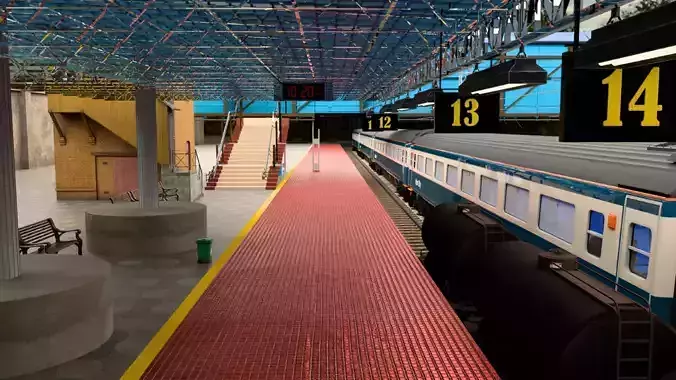A railway station 3D model is a digital representation of a real-world or conceptual train station, created using specialized software. These models are highly detailed and are used for various purposes, including architectural visualization, urban planning, video game development, and historical preservation.
Here's a detailed description of what a typical railway station 3D model would include:
1.
Overall Structure and Layout
-
Main Building: The central hub of the station, often featuring a grand entrance, ticketing halls, waiting areas, and offices. The model would capture the architectural style (e.g., Victorian, modern, brutalist), facade details, and roof structure.
-
Platforms: The elevated areas where passengers board and alight trains. The model would show the length, width, and number of platforms. Details would include:
- Platform markings and lines.
- Benches and seating arrangements.
- Information boards and signage.
- Safety barriers and tactile paving for the visually impaired.
-
Canopies/Roofs: Structures covering the platforms to protect passengers from the elements. These can be simple awnings, elaborate Victorian-style iron and glass roofs, or modern tensile structures. The 3D model would show the structural supports, roofing material, and drainage systems.
-
Tracks: The rail lines running through the station. The model would accurately represent the gauge, number of tracks, and their curvature. Details would include:
- Sleepers (railroad ties).
- Ballast (crushed stone).
- Switches and turnouts.
- Signaling equipment and signals.
-
Overpasses and Underpasses: Bridges or tunnels for pedestrian movement between platforms, or for roads and other tracks to cross the railway line. The model would include stairs, ramps, and elevators.
2.
Interior Details (if modeled)
-
Main Hall/Concourse: The bustling central area. The model would feature:
- Ticket counters and self-service kiosks.
- Information desks.
- Large display screens for train schedules.
- Seating and benches.
- Architectural details like vaulted ceilings, skylights, and ornate flooring.
-
Shops and Amenities: Concession stands, cafes, newsagents, and restrooms. The model would include the storefronts, interior layouts, and specific items on display (e.g., drinks coolers, coffee machines).
-
Waiting Rooms: Detailed seating, tables, and maybe even historical features like fireplaces or decorative wall panels.
-
Offices and Back-of-House: Doors and windows representing staff areas, though the interiors of these are often not fully modeled unless specifically required.
3.
Exterior Details and Environment
-
Signage: Station name signs, platform numbers, directional arrows, and advertisements.
-
Lighting: Lamp posts on platforms, wall-mounted lights on the building, and internal light fixtures. The model can be set up for realistic lighting simulations.
-
Landscaping: Trees, bushes, grass, and flower beds around the station.
-
Street Furniture: Bins, benches, bicycle racks, and bollards.
-
Roads and Pavements: The surrounding roads leading to the station, including pedestrian crossings and parking areas.
-
Vehicles: Taxis, buses, and private cars can be added to the scene to make it more dynamic.
-
People/Characters: Low-poly or detailed character models can be placed in the scene to show scale and activity.
4.
Technical and Artistic Details
-
Texturing: The surfaces of the model are covered with high-resolution textures to represent different materials. This includes:
-
Brick and Stone: Textures with realistic wear and tear, and variations in color.
-
Metal: Rusty metal on tracks, polished steel on railings, and weathered iron on roof structures.
-
Glass: Transparent textures with reflections and smudges.
-
Wood: Detailed grain and imperfections on benches and doors.
-
Polygonal Count: The number of polygons in the model determines its level of detail. A high-poly model is suitable for close-up renders and architectural visualization, while a low-poly model is better for real-time applications like video games.
-
LOD (Level of Detail): A set of models with varying levels of detail can be created. The highly detailed version is used when the camera is close, and a simpler version is used when the camera is far away to optimize performance.
-
File Formats: The model would be available in standard 3D formats like .obj, .fbx, .3ds, and .blend, which are compatible with most 3D software.
In summary, a railway station 3D model is a complex and highly detailed digital asset that serves as a versatile tool for a wide range of applications, from artistic and educational to professional and commercial uses.


























